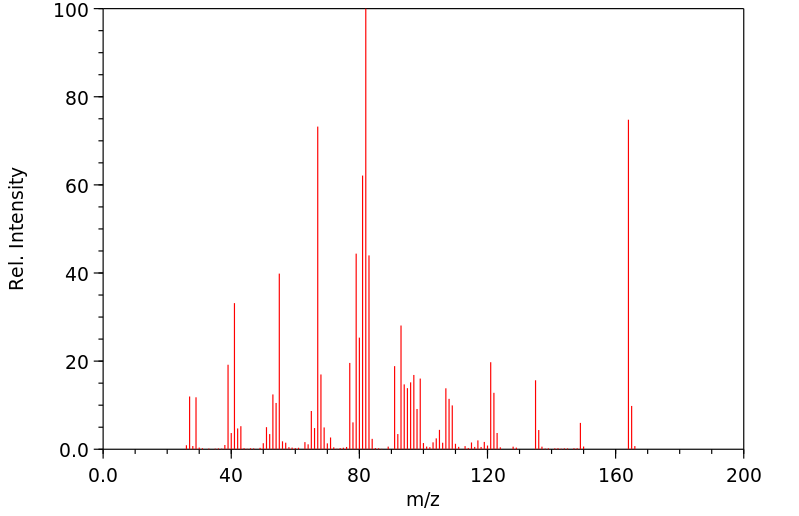环己亚基环己烷 | 4233-18-5
中文名称
环己亚基环己烷
中文别名
——
英文名称
bicyclohexylidene
英文别名
cyclohexylidenecyclohexane;1,1'-bi(cyclohexylidene)
CAS
4233-18-5
化学式
C12H20
mdl
MFCD00019483
分子量
164.291
InChiKey
FJHVMZDLYBHASM-UHFFFAOYSA-N
BEILSTEIN
——
EINECS
——
-
物化性质
-
计算性质
-
ADMET
-
安全信息
-
SDS
-
制备方法与用途
-
上下游信息
-
文献信息
-
表征谱图
-
同类化合物
-
相关功能分类
-
相关结构分类
物化性质
-
熔点:55 °C
-
沸点:236-237 °C
-
密度:0.0109 g/cm3(Temp: 15 °C)
计算性质
-
辛醇/水分配系数(LogP):4
-
重原子数:12
-
可旋转键数:0
-
环数:2.0
-
sp3杂化的碳原子比例:0.833
-
拓扑面积:0
-
氢给体数:0
-
氢受体数:0
安全信息
-
海关编码:2902199090
SDS
反应信息
-
作为反应物:参考文献:名称:烯丙基氢过氧化物与硫酸铁(II)反应引发的区域选择性自由基环化摘要:与硫酸亚铁的混合物1-甲基-2-亚甲基-1-环己基氢过氧化物的治疗4 /的CuCl 2,得到1-(1-氯环)乙酮,与6-一致主要产物内切- trig的中间体5- acetylhex的环化-5-烯基。该策略扩展到一系列1-异丙烯基环烷基氢过氧化物的扩环。区域选择性7-或8-内切- trig的环化反应可通过处理相应的环戊基或环己基氢过氧化物的用任一个的FeSO的混合物来实现4 /的CuCl 2或的FeSO 4只。取代基对8-效率的影响远藤- trig的环化过程中还探讨。DOI:10.1016/s0040-4020(02)01522-3
-
作为产物:描述:dicyclohexylidenehydrazine 在 lead(IV) acetate 、 硫化氢 、 calcium carbonate 、 亚磷酸三乙酯 作用下, 以 二氯甲烷 、 甲苯 、 乙腈 为溶剂, 反应 2.0h, 生成 环己亚基环己烷参考文献:名称:Oligo(cyclohexylidenes): Parent Compounds and End-Functionalized Derivatives摘要:Parent oligo(cyclohexylidenes) 1(n) (n = 1-4) were synthesized using a modified Barton-Kellogg olefin synthesis. Surprisingly, the crude compounds 1(2) and 1(4) contained small amounts of the 1(n-1) and 1(n+1) homologues. As evidenced by a close examination of mass spectral data of selectively deuterated tercyclohexylidenes 1(2)d(4)d(4) and 1(2)-d(8), their formation can be attributed to scrambling of the intermediate azines. With increasing n, a marked decrease in solubility as well as an increase in thermal stability was found. Powder diffraction measurements indicate that the parent compounds 1(n), irrespective of n, pack in a similar fashion in the solid state. The theoretically (MMX, AM1, and ab initio) predicted rodlike structure of the oligo(cyclohexylidenes) was confirmed by single-crystal X-ray structures of 1(1) and three derivatives (12(1), 13(1), and 30(2)). In line with the powder diffraction data in the series 1(n), a similar packing motif was found for the derivatives. To circumvent side product formation due to azine scrambling, a different synthetic approach was used for the preparation of end-functionalized oligo(cyclohexylidenes), i.e. decarboxylation and dehydration of beta-hydroxy acids.DOI:10.1021/jo00119a014
文献信息
-
Photochemistry of alkyl halides—VII作者:Paul J. Kropp、Norbert J. Pienta、Joy A. Sawyer、Richard P. PolniaszekDOI:10.1016/s0040-4020(01)92370-1日期:——The previously observed cyclopropaoation of alkenes by irradiation of diiodomethane (I) in their presence has been studied in more detail and found to be a synthetically useful procedure which is significantly less subject to steric effects than the traditional Simmons-Smith method. The results from photocyclopropanation of a variety of alkenes are summarized in Tables 1 and 3–4. In a number of cases先前观察到的通过二碘甲烷的辐射对烯烃的环丙烷化反应(I)的存在,我们对其进行了更详细的研究,发现它是一种合成上有用的方法,与传统的Simmons-Smith方法相比,其受到的空间位阻明显更少。表1和表3-4汇总了各种烯烃的光环丙烷化结果。在许多情况下,光化学程序提供的结果优于Simmons-Smith方法,尤其是使用空间拥挤的烯烃时。环烯烃显示的光环丙烷化相对速率是环大小的函数,类似于Simmons-Smith方法(表5)。然而,与Simmons-Smith方法相比,光环丙烷化反应的相对速率随着双键取代度的增加而稳定增加(表6),其中空间效应抵消了随着取代作用的增加烯烃的亲核性的提高。α碘化建议使用2作为亚甲基转移物质。在溴化锂存在下,将阳离子2捕集,得到溴碘甲烷。
-
Intermolecular [2 + 2] Photocycloaddition of α,β-Unsaturated Sulfones: Catalyst-Free Reaction and Catalytic Variants作者:Noah Jeremias、Lisa-Marie Mohr、Thorsten BachDOI:10.1021/acs.orglett.1c01794日期:2021.8.62-Aryl-1-sulfonyl-substituted cyclobutanes were prepared in an intermolecular [2 + 2] photocycloaddition from various α,β-unsaturated sulfones and olefins upon irradiation at λ = 300 nm (26 examples, 60–99% yield). Lewis acids catalyzed the [2 + 2] photocycloaddition of 2-benzimidazolyl styryl sulfones. At short wavelengths, the latter substrates underwent C–S bond cleavage but AlBr3 (5 mol %) allowed
-
REDUCTION OF AROMATIC AND ALIPHATIC NITRO COMPOUNDS BY SODIUM HYDROGEN TELLURIDE作者:Atsuhiro Osuka、Hirohito Shimizu、Hitomi SuzukiDOI:10.1246/cl.1983.1373日期:1983.9.5Various nitro compounds were effectively reduced by sodium hydrogen telluride in good yields. Thus, reductive conversion of unhindered nitrobenzenes to azoxybenzenes, sterically hindered nitrobenzenes to anilines, nitroalkanes to dimer of nitrosoalkanes, and vicinal-dinitroalkane to olefin was achieved.
-
Regioselective and Stereospecific Copper-Catalyzed Deoxygenation of Epoxides to Alkenes作者:Jingxun Yu、Yu Zhou、Zhenyang Lin、Rongbiao TongDOI:10.1021/acs.orglett.6b02405日期:2016.9.16diazo malonate for chemo-/regioselective and stereospecific deoxygenation of various epoxides with tolerance of common functional groups (alkene, ketone, ester, p-methoxybenzyl, benzyl, tert-butyldimethylsilyl, and triisopropylsilyl). In particular, the unprecedented regioselectivity allowed for the first time monodeoxygenation of diepoxides to alkenyl epoxides. Density functional theory mechanistic studies
-
Hydroalumination of alkenes by the LiAlH4 � 3AlBr3 system作者:E. V. Gorobets、O. V. Shitikova、S. I. Lomakina、G. A. Tolstikov、A. V. KuchinDOI:10.1007/bf00699198日期:1993.93AlBr3 system in low-polar solvents was studied. Alkenes with mono-, di-, tri-, and tetraalkyl substituted, mono- and diaryl substituted double bonds and anthracene react at room temperature to give the corresponding dibromoaluminoalkanes in high yields. Benzylidenefluorene, tetraphenylethylene, naphthalene, and phenanthrene do not undergo hydroalumination under these conditions. Camphene, bicyclo[3.2
表征谱图
-
氢谱1HNMR
-
质谱MS
-
碳谱13CNMR
-
红外IR
-
拉曼Raman
-
峰位数据
-
峰位匹配
-
表征信息
同类化合物
高密聚乙烯
香叶醇
顺式3-甲基-2-己烯
顺式-5-癸烯
顺式-5-甲基-2-己烯
顺式-5-庚烯-1-炔
顺式-4-癸烷
顺式-4-甲基-2-戊烯
顺式-4-甲基-2-戊烯
顺式-3-癸烯
顺式-3-甲基-3-己烯
顺式-3-甲基-2-庚烯
顺式-3-戊烯-1-炔
顺式-3,4-二甲基-3-己烯
顺式-3,4-二甲基-2-戊烯
顺式-3,4-二甲基-2-戊烯
顺式-2-甲基-3-己烯
顺式-2-壬烯
顺式-2-丁烯-D1
顺式-1.1.1-三甲基-2-丁烯
顺式-1-甲基-2-环丙基乙烯
顺式-1-甲基-2-乙烯基环戊烷
顺式-1-环戊基-1-辛烯
顺式-1-氘代-3-甲基-1-丁烯
顺式-(9ci)-2,3,3a,7a-四氢-4-(1-甲基乙基)-1H-茚
顺式-(2-丁烯基)环丙烷
顺式,顺式-2,4-己二烯
顺-环辛烯
顺-9-二十一碳烯
顺-6-十三碳烯
顺-5-甲基-1,3,6-庚三烯
顺-4-辛烯
顺-4-壬烯
顺-3-辛烯
顺-3-甲基-2-戊烯
顺-3-壬烯
顺-3-十三碳烯
顺-2-辛烯
顺-2-癸烯
顺-2-戊烯
顺-2-庚烯
顺-2-己烯
顺-2-丁烯
顺-2,2-二甲基-3-己烯
顺-1,3-戊二烯
顺,顺-1,9-环十六烷二烯
顺,顺,顺-环癸-1,3,5-三烯
间戊二烯
间二(4-吡啶基)苯
镁,二-2-丁烯基-







